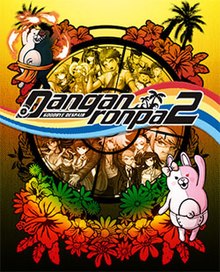| Danganronpa 2: Goodbye Despair | |
|---|---|
 Cover art featuring Monokuma (left), Monomi (right), and the students of Hope's Peak Academy | |
| Developer(s) | Spike Chunsoft[a] |
| Publisher(s) | Spike Chunsoft[b] |
| Director(s) | Takayuki Sugawara |
| Producer(s) |
|
| Designer(s) | Shun Sasaki |
| Programmer(s) | Kengo Ito |
| Artist(s) | Rui Komatsuzaki |
| Writer(s) |
|
| Composer(s) | Masafumi Takada |
| Series | Danganronpa |
| Engine | Unity (Anniversary) |
| Platform(s) | |
| Release | July 26, 2012
|
| Genre(s) | Adventure, visual novel |
| Mode(s) | Single-player |
Danganronpa 2: Goodbye Despair[c] is a 2012 visual novel developed by Spike Chunsoft. It is the second game in the Danganronpa franchise following Danganronpa: Trigger Happy Havoc (2010). It was first released in Japan for PlayStation Portable in July 2012, and a port for PlayStation Vita was released in Japan in October 2013. NIS America released the game worldwide in September 2014; a port for PC was released in April 2016 and a bundle for PlayStation 4 and Playstation Vita called Danganronpa 1-2 Reload, also containing the first Danganronpa game, was released in March 2017. An enhanced version with the subtitle Anniversary Edition was released for Android and iOS in August 2020, for Nintendo Switch in November 2021, and for Microsoft Windows and Xbox One May 2022.
Development of the game started as Kazutaka Kodaka was writing the tie-in prequel light novel to Trigger Happy Havoc, Danganronpa Zero, and added hints about a sequel to the novel following their approval, revolving around the mysterious Izuru Kamukura. Kodaka aimed to develop a unique plot to give players more mysterious elements in a group of islands, inspired by the television series Lost. The protagonist Hajime Hinata is part of a group of high-school students who are trapped on a tropical island by their high school's headmaster Monokuma, a sentient stuffed bear, along with Monomi, a sentient stuffed rabbit. Similar to the first game, to leave the island, students must kill one of their peers and not be caught in the subsequent investigation and trial.
The game was well received based on sales and critics. Critical response to the game's narrative and cast was generally favorable. However, the gameplay elements involving class trials earned mixed responses; some writers found some parts of the game uninteresting, while early ones proved unchallenging. Danganronpa 2: Goodbye Despair was followed by the spin-off Danganronpa Another Episode: Ultra Despair Girls, which was released on September 25, 2014, and the anime Danganronpa 3: The End of Hope's Peak High School, which ran from July 11, 2016, to September 29, 2016. A loose sequel to the series, called Danganronpa V3: Killing Harmony, with similar gameplay but a different storyline was released on January 12, 2017.
- ^ "Archived copy" (PDF). Archived from the original (PDF) on September 8, 2014. Retrieved April 18, 2014.
{{cite web}}: CS1 maint: archived copy as title (link) - ^ Danganronpa And Danganronpa 2 PC Ports Only The Beginning For Spike Chunsoft, Siliconera
- ^ "Danganronpa And Danganronpa 2 PC Ports Only The Beginning For Spike Chunsoft". Siliconera. January 19, 2016.
- ^ Romano, Sal (July 16, 2020). "Danganronpa 2: Goodbye Despair Anniversary Edition for iOS and Android launches August 20". Gematsu. Retrieved July 16, 2020.
Cite error: There are <ref group=lower-alpha> tags or {{efn}} templates on this page, but the references will not show without a {{reflist|group=lower-alpha}} template or {{notelist}} template (see the help page).